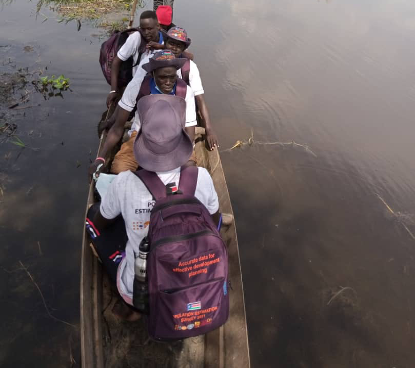Historic progress in South Sudan’s drive to count its population
Enumeration for South Sudan’s Population Estimation Survey (PES) has been completed, marking the end of the single largest data collection effort in the country’s history. Survey field work began on 24 May and was carried out by South Sudan’s National Bureau of Statistics (NBS), with support from GRID3, the United Nations Population Fund (UNFPA), and various stakeholders. More than 600 enumerators and supervisors implemented the PES, collecting data across all ten of the country’s states and its three administrative areas.
Before now, the most recent official population data for South Sudan were found in the Sudan Population and Housing Census of 2008, conducted prior to South Sudan’s independence in 2011. In the years since, political conflict and linked population movements rendered the 2008 numbers outdated, and there was an urgent need to produce up-to-date, accurate, relevant demographic data that could inform the country’s development agenda.
Crossing the finish line
The PES is the culmination of extensive planning and coordination. In addition to the design of the survey (in a microcensus, the questionnaire is shorter and the survey covers a smaller number of households than a full national census), the NBS, GRID3, UNFPA, and other partners had to recruit and train enumerators in each state, obtain tablets from UN partner agencies (which were then uploaded with the questionnaires and maps of sample sites), and devise a strategy for the roughly three-week-long exercise. Enumerators and their supervisors had to negotiate many challenges in the field, including poor internet access, inconsistent power supplies, and travel to politically unstable areas. They effectively navigated these obstacles with the aid of the PES’s well-crafted technical procedures, as well as the survey staff’s ability to come up with creative solutions in short timeframes, including the use of canoes and tractors to access particularly hard-to-reach areas.
Enumerators use canoes while in Unity state, Rubkona county, South Sudan.
The collected data were transferred to a cloud server, where they were aggregated in real time and subjected to continuous quality checks by a data quality assurance team based in Juba. When inconsistencies were detected (such as incorrect GPS points and missing variables), field teams returned to households to obtain the correct data, which were then cross-checked against the database.
Save for Panyijar County (where insecurity is making enumeration especially difficult), all data have been submitted by the field teams; 1,491 of 1,536 of the sample sites have been reached. Concurrently, the NBS, GRID3 and UNFPA are devising plans to clean and analyse the data, and will produce a report describing the experience in the field as well as some preliminary survey results. For its part, GRID3 is preparing to model country-wide population estimates that rely on the PES data; these new estimates will improve the accuracy of the programme’s existing population estimates.
The PES will provide both short- and long-term benefits. Most immediately, it can be used to measure coverage (i.e. how many households are interviewed in a given area) during the country’s 2020 population and housing census round; provide a foundation for surveys relating to demographic health and growth; inform advocacy materials for policymakers; and inform modelled infrastructure data for the country’s various ministries. Looking further ahead, the gridded population estimates resulting from the PES will increase the availability, accessibility, and utilisation of reliable data on population size and basic demographic characteristics. These estimates can be used to improve targeted development interventions such as vaccination campaigns and efforts to increase school enrollment.

